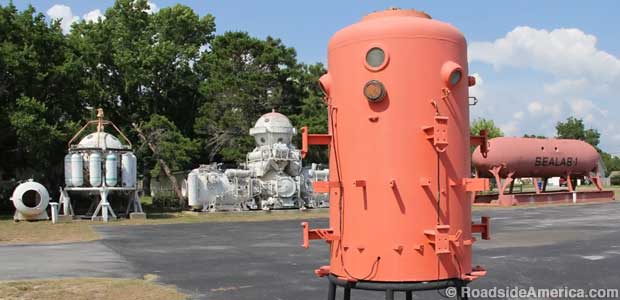
Man's various clanky homes, formerly in the sea. Famous SeaLab-1 is on the right.
Man in the Sea Museum
Panama City Beach, Florida
Fronting on US Highway 98, nestled between an Express Lube and a real estate office, is a parking lot surrounded by what look like industrial boilers and gas pipeline equipment. This is the Man in the Sea Museum, and the heavy iron is what Man has to surround himself with to keep the Sea from killing him.
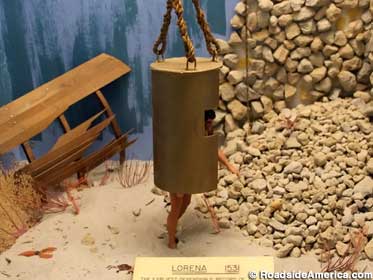
Ken doll strolls the ocean floor for treasure.
Signs, baked by the Panhandle sun, describe the various survival pods and mini-subs. They include the Techdiver, which scooped up an atom bomb that fell into the ocean in 1966, and SeaLab-1, one of the most museum-worthy relics in all of Florida, which is a walk-through attraction with exhibits inside. Four men spent 11 straight days inside SeaLab-1, nearly 200 feet underwater, in July 1964. At the time no one knew what would happen when multiple humans tried to live so long in an environment with no outside air, and it was a lot cheaper to find out by dropping them into the sea than by blasting them into space.
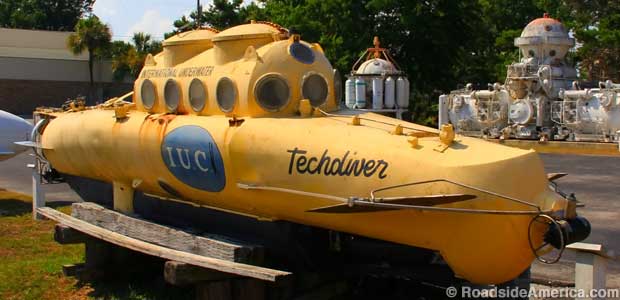
Techdiver grabbed an atom bomb that accidentally fell into the sea.
SeaLab-1 was the brainstorm of the U.S. Navy Mine Defense Lab, which is headquartered in Panama City Beach along with several other military and civilian ocean research programs. This gathering of waterlogged trailblazers is the reason the museum is here, and veteran Navy divers made up much of its initial volunteer staff. Ironically, Panama City Beach is even more popular with party-and-vacation visitors who care about being at the sea, but not underneath it. This leaves the Man in the Sea Museum often scrambling to attract the attention of people who probably think SeaLab-1 is an above-ground propane tank, which it does kind of resemble.
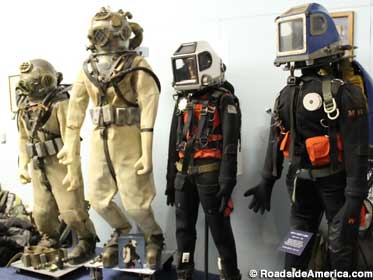
Classic "Diver Dan" suits on left, Cold War suits on right.
Inside, the museum has the amiable clutter of a summer beach house, which, although unintentional, does give a good suggestion of the claustrophobia of underwater living.
Just inside the front door are a series of miniature dioramas, built with loving care, offering a chronological history of human attempts to survive underwater. They are populated mostly by Ken dolls in outrageous gear: breathing tubes and leather sacks, giant deep-fryer pot helmets, watertight barrels with armholes, and lots of rocks-in-pockets to prevent floating away. Small labels explain that the motivation behind this technical envelope-pushing was mostly not pure knowledge, but attempts to grab pearls or booty that had sunk.
A display of masks and head gear, much of it experimental, show the lengths to which people would go to see and breathe where there was little light and no air. Earlier models resemble old one-if-by-land-two-if-by-sea lanterns, or the classic round-headed deep-sea diver, while more modern versions look like the heads of Bender the robot or Star Wars stormtroopers. A monstrous full-bodied "armored diving suit" from 1913 appears to be made of cement, with claws for hands, and was used to haul millions of dollars in gold from a sunken ocean liner.
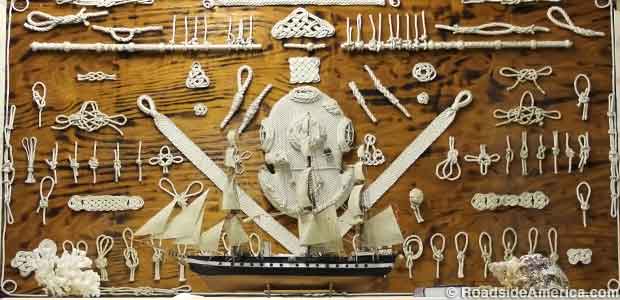
Knot board from the New Jersey School of Salvage.
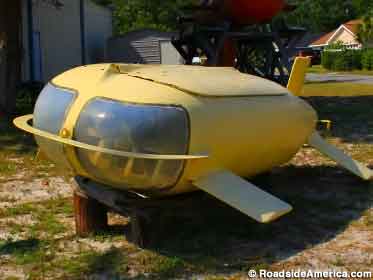
Aerojet Minisub planted mines and detected foreign intruders, according to its sign.
The Beaver, a deep ocean research submarine from the 1970s, is open for inspection via a ladder. The sub could operate at depths of 2,000 feet (It was popular for oil exploration). Climbing into and through the Beaver, it's clear that living in the sea is still restricted to the limber and thin.
The exhibits in the museum make it clear that being "in" the sea is very different from snorkeling on the surface with the pretty fish, which is why much of the gear here is so industrial. There are no-nonsense flippers and air tanks, displays of Cold War mines, and references to "classified mission dives." Videos on TV monitors provide background; you can hear the SeaLab men chattering away like chipmunks (a result of "helium speech descrambling"), and watch a guy who claims that WWII German U-boats would surface off Panama City Beach so their crews could sneak ashore to drink beer in local bars.
Man in the Sea Museum is one of those specialty collections with more stuff than space, a horde worthy of any sunken galleon. There's an elaborate "knot board" from the New Jersey School of Salvage, and the shellacked and mounted body of Goldie, the U.S. Navy Experimental Dive Unit's mascot goldfish ("Successfully completed 129 dives"). An emergency decompression bag sits next to the age-toned plaque congratulating the museum on its opening on March 6, 1982.
Many such finds await the patient visitor with a laid-back pace. Just imagine you're slowly walking through water at the bottom of the sea....





